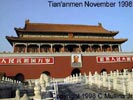
Moving to Beijing was like a dream... that is until you first drive into, or walk into, Tian'AnMen Square and see the overpowering image that is the front entrance to the Imperial Palace - Tian'AnMen gate. Who does not recognize the image of Mao Ze Deng first leader of the People's Republic of China hanging above the entryway? The image of his portrait above the entrance to the once restricted Imperial Palace is cemented in the minds of the world.
Within the Imperial Palace walls, imagine the lifestyle of the emperors, the self-identified 'sons of heaven', nearly 400 years ago, isolated by a series of concentric walled enclosures into which only a few may enter for an audience with the emperor.
Separate buildings for introductions with different classes of people. Inside each complex the emperor would sit on an imposing throne as the visitor kneeled at his feet.
But there are other fascinating sites in Beijing as well. It was well understood in ancient China that the emperor ruled with the 'mandate of heaven.' As long as the emperor held that mandate, the country would prosper. If crops failed, or foreigners invaded, the people believed it was a sign the emperor had lost the mandate of Heaven and a new leader would ascend the throne.
In order to appease the gods and maintain the mandate of heaven, emperors would make sacrifices in elaborate ceremonies. Tian Tan, the Temple of Heaven, south of the Imperial Palace, was built specifically for that purpose. Laid out facing south, towards the sun, the annual harvest sacrifice ceremony would begin at the Hall of Prayer for Good Harvest, the largest wooden structure in Beijing. Inside, the chief priests would present anything from grain to cattle for sacrifice.
After the sacrifices were presented, the procession would continue to the Hall of Heaven to pray the gods would accept the sacrifices. And finally the ceremony would end on the Altar of Heaven.
As Tian Tan is considered a public park, there are other parks worth visiting. Beihai Park just north of the Imperial Palace is famous for a large stupa atop a hill in the center of the lake. Stupas contain relics, such as leg and finger bones, of famous buddhas which believers cherish.
The Summer Palace is probably the most famous park in Beijing. Surrounding an enormous man-made lake, members of the royal family could escape the heat of the city in the summer. Entering from the north gate visitors can see the detail the emperors expected in all aspects of their lives. A beautiful temple was built overlooking the lake. Inside the temple artists must have spent weeks painting sacred images.
Sometime around the 12th century AD, Buddhism began to spread in China. Although any religion now is officially discouraged, Tibetan Buddhism played a major role in shaping Chinese values. In Beijing, the Lama Temple is a wonderful example of Tibetan architecture. The ornate main gate demonstrates the importance of the Temple grounds. The main temple building houses a huge statue of Buddha.
Thank you for taking a quick tour of Beijing. Click on one of the hyperlinks at the top of the page to view another tour. Not all tours are active yet so please be patient.
Copyright (c) 2000 C Mullins Jr. All rights reserved. No portion of this website may be copied or reproduced in any form without prior written authorization of the copyright holder.